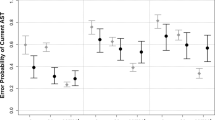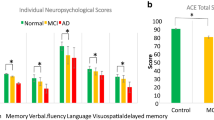Abstract
The anti-saccade task (AST) is widely used in experimental, clinical, and neuroscience research as a pronounced test of executive functions. AST research includes to some extent also the investigation into its cognitive correlates. In the present study, we have examined cognitive correlates of the AST in the short-term/working memory, executive functions, and intelligence domains in healthy adults. We have obtained the following results. In line with previous research, the global percentage of direction errors PDE comprised of two only negligibly correlated components, direction errors with express or regular latencies. Substantial correlations with the other cognitive measures were obtained only for regular direction errors and, less so, for the global PDE. Results add to the evidence that distinguishes express and regular direction errors and underline that the complex requirements of the AST are reflected in a comparatively rich set of non-redundant parameters.
Similar content being viewed by others
References
Baddeley AD (1998) The central executive: a concept and some misconceptions. J Int Neuropsychol Soc 4:523–526
Callicott JH, Mattay VS, Bertolino A, Finn K, Coppola R, Frank JA et al (1999) Physiological characteristics of capacity constraints in working memory as revealed by functional MRI. Cereb Cortex 9:20–26
Carroll JB (1993) Human cognitive abilities. Cambridge University Press, Cambridge
Claeys K, Crevits L, Stuyven E, Van der Goten K, Depuydt C, Vandierendonck A (1999) Parallel visual and memory processes. Doc Ophthalmol 95:349–358
Colom R, Abad FJ, Rebollo I, Shih PC (2005) Memory span and general intelligence: a latent-variable approach. Intelligence 33:623–642
Colom R, Abad FJ, Quiroga MA, Shih PC, Flores-Mendoza C (2008) Working memory and intelligence are highly related constructs, but why? Intelligence 36:584–606
Cortina JM, Nouri H (2000) Effect size for ANOVA designs. Sage, Thousand Oaks
Donchin E, Coles MGH (1988) Is the P300 component a manifestation of context updating? Behav Brain Sci 11:357–374
Duncan J, Burgess P, Emslie H (1995) Fluid intelligence after frontal lobe lesions. Neuropsychologia 33:261–268
Eenshuistra RM, Ridderinkhof KR, van der Molen MW (2004) Age-related changes in antisaccade task performance: inhibitory control or working-memory engagement? Brain Cogn 56:177–188
Evdokimidis I, Smyrnis N, Constantinidis C, Stefanis NC, Avramopoulos D, Paximadis C et al (2002) The antisaccade task in a sample of 2.006 young men: I. Normal population characteristics. Exp Brain Res 147:45–52
Fischer B, Weber H (1993) Express saccades and visual attention. Behav Brain Res 16:553–610
Godefroy O, Cabaret M, Petit-Chenal V, Pruvo JP, Rousseaux M (1999) Control functions of the frontal lobes. Modularity of the central supervisory system? Cortex 35:1–20
Gooding DC, Basso MA (2008) The tell-tale tasks: a review of the saccadic research in psychiatric patient populations. Brain Cogn 68:371–390
Hallett PE (1978) Primary and secondary saccades to goals defined by instructions. Vis Res 18:1279–1296
Heller KA, Kratzmeier H, Lengfelder A (1998) Standard progressive matrices/matrizen-test-manual (band 1). Beltz Test
Hutton SB (2008) Cognitive control of saccadic eye movements. Brain Cogn 68:327–340
Jaeger AO, Suess HM, Beauducel A (1997) Berliner intelligenzstruktur-test. BIS-test, form 4. Hogrefe, Goettingen
Jensen AR (1982) The chronometry of intelligence. In: Sternberg RJ (ed) Advances in the psychology of human intelligence, vol 1. Erlbaum, Hillsdale, NJ
Johnston K, Everling S (2008) Neurophysiology and neuroanatomy of reflexive and voluntary saccades in non-human primates. Brain Cogn 68:271–283
Jung RE, Haier RJ (2007) The parieto-frontal integration theory (P-FIT) of intelligence: converging neuroimaging evidence. Behav Brain Sci 30:135–187
Klein C (2001) Developmental functions for parameters derived from pro- and anti-saccade tasks in 199 participants aged 6–28 years. Exp Brain Res 139:1–17
Klein C, Fischer B (2005) Developmental fractionation and differential discrimination of the anti-saccadic direction error. Exp Brain Res 165:132–138
Klein C, Berg P, Rockstroh B, Andresen B (2000) Topography of the auditory P300 in Schizotypal personality. Biol Psychiatry 45:1612–1621
Kuntsi J, Oosterlaan J, Stevenson J (2001) Psychological mechanisms in hyperactivity: I. Response inhibition deficit, working memory impairment, delay aversion, or something else? J Child Psychol Psychiatry 42:199–210
Kyllonen PC, Christal P (1990) Reasoning ability is (little more than) working memory capacity?!. Intelligence 14:389–433
Linden DEJ, Bittner RA, Muckli L, Waltz JA, Kriegeskorte N, Goebel R et al (2003) Cortical capacity constraints for visual working memory: dissociation of fMRI load effects in a fronto-parietal network. NeuroImage 20:1518–1530
Luna B, Velanova K, Geier CF (2008) Development of eye movement control. Brain Cogn 68:293–308
Massen C (2004) Parallel programming of exegenous and endogenous components in the antisaccade task. Q J Exp Psychol 57:475–498
McDowell JE, Dyckman KA, Austin BP, Clementz BA (2008) Neurophysiology and neuroanatomy of reflexive and volitional saccades: evidence from studies of humans. Brain Cogn 68:255–270
Müri RM, Nyffeler T (2008) Neurophysiology and neuroanatomy of reflexive and volitional saccades as revealed by lesion studies with neurological patients and transcranial magnetic stimulation (TMS). Brain Cogn 68:284–292
Reuter B, Kathmann N (2004) Using saccade tasks as a tool to analyse executive dysfunctions in schizophrenia. Acta Psychol 115:255–269
Roberts RJ, Hager LD, Heron C (1994) Prefrontal cognitive processes: working memory and inhibition in the antisaccade task. J Exp Psychol Gen 123:374–393
Rogers RD, Monsell S (1995) Costs of a predictable switch between simple cognitive tasks. J Exp Psychol Gen 124:207–231
Rommelse NNJ, Van der Stigchel S, Sergeant JA (2008) A review on eye movement studies in childhood and adolescent psychiatry. Brain Cogn 68:391–414
Schweizer K (1995) Hypothesen zu den biologischen und kognitiven Grundlagen der allgemeinen Intelligenz. Z Differ Diagn Psychol 16(2):67–81
Schweizer K (2005) An overview of research into the cognitive basis of intelligence. J Individ Differ 26:43–51
Shapiro KL (1998) Temporal methods for studying attention: how did we get here and where are we going? In: Shapiro K (ed) The limits of attention. Oxford University Press, Oxford, pp 1–19
Smyrnis N (2008) Metric issues in the study of eye movements in psychiatry. Brain Cogn 68:341–358
Sternberg S (1966) High-speed scanning in human memory. Science 153:652–654
Stuss D, Murphy KJ, Binns MA, Alexander MP (2003) Staying on the job: the frontal lobes control individual performance variability. Brain 126:2363–2380
Stuyven E, Van der Goten K, Vandierendonck A, Claeys K, Crevits L (2000) The effect of cognitive load on saccadic eye movements. Acta Psychol 104:69–85
Tranel D, Anderson SW, Benton AL (1995) Development of the concept of executive function and its relationship to the frontal lobes. In: Boller F, Grafman J (eds) Handbook of neuropsychology, vol 9. Elsevier, Amsterdam, pp 125–148
Zimmermann P, Fimm B (1993) Testbatterie zur Aufmerksamkeitsprüfung (TAP) Version 1.0: Handbuch. Psytest
Author information
Authors and Affiliations
Corresponding author
Rights and permissions
About this article
Cite this article
Klein, C., Rauh, R. & Biscaldi, M. Cognitive correlates of anti-saccade task performance. Exp Brain Res 203, 759–764 (2010). https://doi.org/10.1007/s00221-010-2276-5
Received:
Accepted:
Published:
Issue Date:
DOI: https://doi.org/10.1007/s00221-010-2276-5




